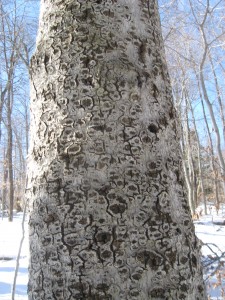 The bark of beech is famously smooth, providing a space for people to carve their initials. But most beech in the Northeast, and almost all in the Catskills, is infected with beech bark disease, an imported European pathogen to which the American species has no resistance. The young trees grow fine, until they reach about four inches in diameter, when they start to show signs of the disease. For large trees, above a foot in diameter, the infection rate is nearly a hundred percent and the trees eventually succumb. Beech is the only hardwood tree that can regenerate here in the Catskills under current levels of deer browse, but due to bark disease very few individuals will reach canopy-tree size in the next few hundred years. Many trees do produce nuts, however, even with the disease, so there is hope that the tree can breed itself into resistance, with more bark-disease-resistant individuals succeeding better than their fellows. Because of the extinction of the American chestnut, the beech is the only mast species in the high Catskills – the only tree that provides nuts for bear, deer, squirrels, chipmunks, turkeys, etc.
The bark of beech is famously smooth, providing a space for people to carve their initials. But most beech in the Northeast, and almost all in the Catskills, is infected with beech bark disease, an imported European pathogen to which the American species has no resistance. The young trees grow fine, until they reach about four inches in diameter, when they start to show signs of the disease. For large trees, above a foot in diameter, the infection rate is nearly a hundred percent and the trees eventually succumb. Beech is the only hardwood tree that can regenerate here in the Catskills under current levels of deer browse, but due to bark disease very few individuals will reach canopy-tree size in the next few hundred years. Many trees do produce nuts, however, even with the disease, so there is hope that the tree can breed itself into resistance, with more bark-disease-resistant individuals succeeding better than their fellows. Because of the extinction of the American chestnut, the beech is the only mast species in the high Catskills – the only tree that provides nuts for bear, deer, squirrels, chipmunks, turkeys, etc.
It is impressive how damaged the forest is, when you look closely at it. The Catskill forest consists of only about ten or so full-sized tree species: sugar maple, red maple, beech, black cherry, white ash, yellow birch, white pine, hemlock, and (once) chestnut. The chestnut is gone, the hemlock is affected by woolly adelgid and has mostly been wiped out, the white ash is now affected by the emerald ash borer and is expected to be wiped out, the beech is all diseased, there is a white pine disease and there has been an unexplained decline in sugar maple. And because of deer, there are no young trees except pine and beech. Sometimes I feel it will all be fine, and other times I think I’m just enjoying the last cocktail on the Titanic.
Post a Comment